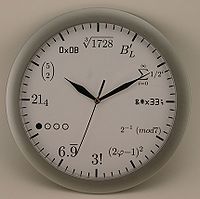Lecture 14
Readings For This Lecture
Keshet Course Notes:
- Chapter 7, pages 137 to 146 (up to subsection 7.7)
Summary
Group 8: Add a summary of the lecture in this space. Include examples, discussion, and links to external sources, if desired.
Exercises
1. Suppose you have 6 books and you want to put 3 on the book shelves. how many possible arrange- ments are there?
| [show]Solution
|
|
Use permutation where n = 6 and k = 3.
6!/(6-3)! = 6*5*4 =120 possible ways
|
2. How many ways are there to get a total of 8 by tossing two die simultaneously ? (consider that a 2 for dice #1 and a 6 for dice #2 is different from a 6 for dice #1 and a 2 for dice #2)
| [show]Solution
|
|
For this you can make a table of with the first die being incremented along the columns. The rows would be increments of the second dies.
This will give you 36 permutations of two dice.
You can see visually along a diagonal that the sum of 8 occurs 5 times.
|
3. How many ways are there to get 3 times H and 2 times T by tossing a fair coin 5 times? What is the probability of getting 3 heads in 5 fair coin tosses?
| [show]Solution
|
|
You can get the number of possible combinations of 5 values that can be either heads or tails by, 2^5 = 32.
One could make a table with 32 outcomes and count.
I made up 5 placeholders for the coin flip results. My order of counting 3 heads the different combinations of 3 heads was to start off with a H in position 1, and exhausting all options when a H in the first place.
Starting in 1st place there are 6 combinations utilizing 3 heads.
HHH _ _, HH _ H _, HH _ _ H, H_HH_, H_H_H, H_ _HH.
Following the same pattern for a head starting in the second place you get 3 combinations.
With head starting in 3rd place you get 1 combination.
That makes 10 ways of getting 3 heads (and two tails) in 5 coin flips.
This number is also equal to the 
Probability of getting 3 heads and two tails is equal to 
|
4. How many words can be made from the word “calculus”? (These words do not have to have any meaning. For examples, “alcuclus”, “lcaluscu”.)
| [show]Solution
|
|
There are 5 distinct letters. The C, L and U are doubled.
For the first letter of the new word, you can have 5 different letters fit in. In the second letter of the new word, you only have 4 different letters left. For the third letter you have 3 choices, the fourth letter you have 2 choices, and the fifth letter you have 1 choice left of the distinct. The remaining three letters will be substituted by the 3 doubled letters... C, L, U. So for the sixth letter you have 3 choices, the seventh you have 2 and the eighth letter you have 1 choice.
The total number of ways is 5*4*3*2*1*3*2*1 = 720 ways
Hey, so tell me if i'm wrong, but it seems like you're incorrectly breaking this up. You first find the permutations of 5 distinct values. Then you find the permutations of 3 distinct values. Then you multiply those permutations.
What do you think of finding the permutations of 8 letters/values(8!), then dividing that by the number of ways you could switch the letters without the word being different. ( 2! * 2! * 2! = 8)
So the answer would be 
-Jesse
|
5. A biased coin has non-equal probabilities of tossing H or T.  and
and  . What is the probability of obtaining exactly 6 heads and 4 tails if you toss the coin 10 times.
. What is the probability of obtaining exactly 6 heads and 4 tails if you toss the coin 10 times.
| [show]Solution
|
|
This is a Bernoulli trial because there are two possible outcomes, with probability of the coin flip being heads 75% of the time.
So, 
|






